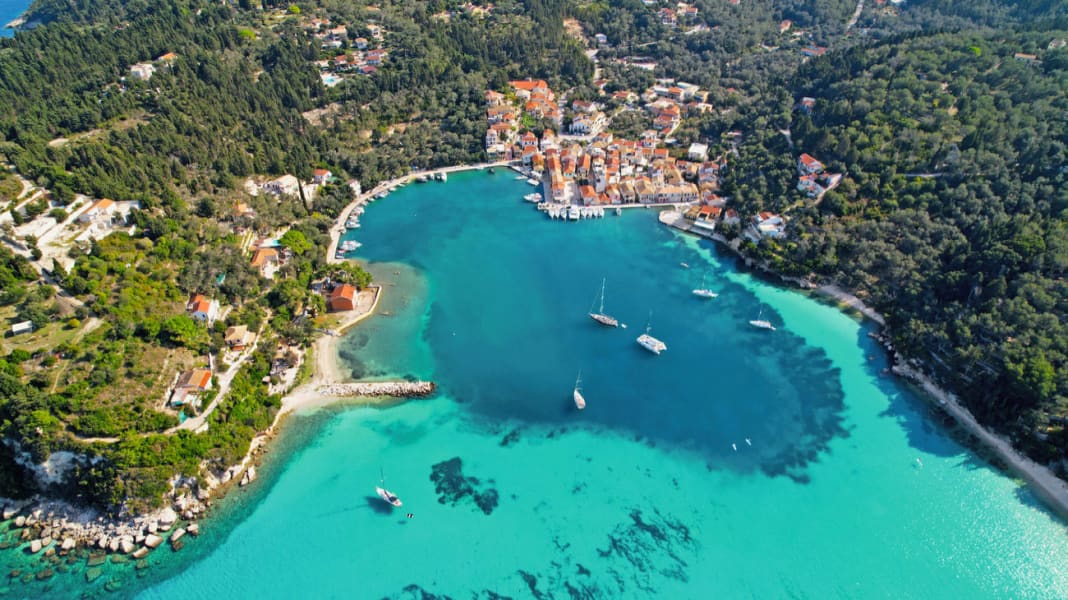
Homer would have enjoyed this monster - after all, the foremost poet of ancient Greece had a weakness for dramatic performances. Perhaps he would even have placed it alongside Scylla and Charybdis, thisduo infernale among the sea monsters. In a threesome, they could have made life on the high seas even more difficult for Odysseus, who was already plagued enough. What did it matter that even then it was not real creatures that frightened Homer's contemporaries when they read his lines, but powerful natural phenomena? Hesealed finally. A little artistic licence was allowed - and the effect remained the same. Even today, almost three thousand years later, there are simple scientific explanations for what is actually lurking out there far beyond the horizon on this day at the end of October: a hurricane. This type of monster is not actually at home in the Mediterranean. The atmospheric maelstrom measures several hundred nautical miles in diameter, with its centre moving slowly back and forth between the southern tip of Sicily and the Great Syrte. The coloured map in our weather app shows the wind speeds around the eye as an angry red ring, while the inside of the eye is calm and deep blue. As blue as the painted eyes on the bow of the fishing boats below us in the old harbour of Corfu. They are supposed to protect against the evil eye, against disaster - and against storms.
Below the fortress
We are almost standing on the highest pinnacle of the New Fortress, with the crumbling defence wall in front of us and the proud flag of Greece above us. The blue and white striped fabric hangs limply. And if we look to the south, over the interlocking roofs of the old town and beyond, we can see the sparkling surface of the Corfiot Sea, which separates the island from the mountainous mainland. Even there, we can't find any signs of the weather monster. No waves, no clouds. Summer seems to be far from over here.
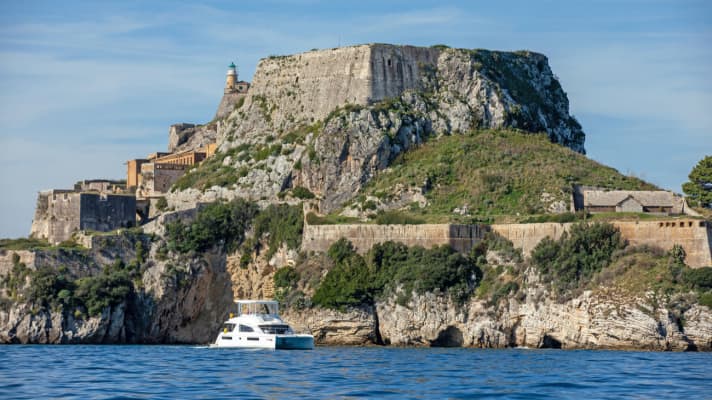
It may be that this peace is due to the fact that Poseidon himself once made this island the refuge of the nymph Kerkyra so that she could give birth to their child here in peace. Perhaps this divine protection is still at work? After all, her name is the Greek for Corfu. Or maybe it's because the Corfiot Sea has only narrow access to the open Ionian Sea to the south and north and is therefore generally quite well protected. Or maybe we're just lucky this time - the huge cyclone is rotating about a hundred nautical miles too far south.
The hub of the Ionian Sea
Our charter trip began two days ago at jetty L of Gouvia Marina. Located just under ten kilometres north of the city of Corfu, the harbour is one of the largest of its kind in Greece with more than 1,200 berths. This makes it the hub of the Ionian Sea, especially for the charter industry. The Moorings also has its base here, and our 434 Powercat is part of the fleet. In the height of summer, the facility may resemble a beehive, but now it's completely different: the fact that there are hardly any gaps in the long rows of sailing and motor yachts is an unmistakable sign that the end of the season is just around the corner. In fact, the week that lies ahead of us is the last. The winter break begins at the end of October.
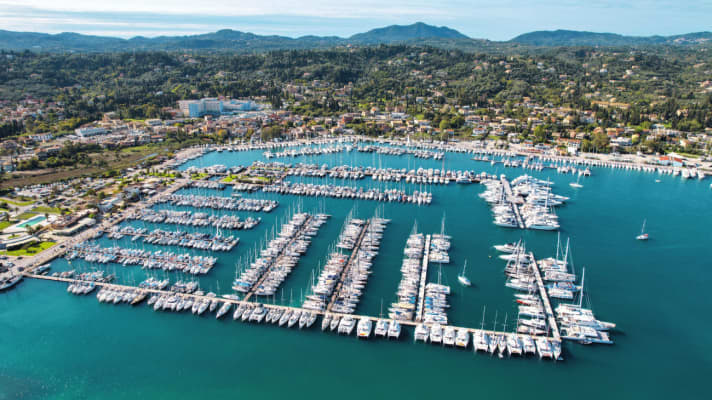
No hustle and bustle, no crowds. All the better! Luggage and shopping are on board and we cast off the next morning. While the sails are unfurled around us and one flybridge after another gets its fixed tarpaulin pulled over, we leave the bay of Gouvia under a bright blue sky for a detour to the north of the island before heading to the capital Corfu in the afternoon. Over the next few hours, we follow the coast in a wide arc to the north-east, past the almost deserted beaches of Ipsos, Dassia and Mparmpati with their hotel complexes. Luckily, you won't find any concrete bed castles here; even the larger complexes blend in with the - even now in late summer still surprisingly green - surroundings. The lush nature, which includes millions of olive trees, is due to Corfu's exposed western location, which regularly provides mild rain in winter.
View from Greece to Albania
The panorama to the north is dominated by a barren rocky cone, leaning against a high plateau, with a transmission mast at the top: at around nine hundred metres, the Pantokrator is Corfu's highest mountain. In fact, the "all-ruler" towers above all the surrounding land and sea. A little further north, in the area of the northern Strait of Corfu, which is only around one nautical mile wide at its narrowest point and separates the island from the Albanian mainland, there are a few designated anchor bays. However, as the wind is expected to pick up overnight from the south-east, which would mean it would be coming from the wrong direction, we follow our original plan and set course for Corfu. Thanks to the two hulls and the autopilot, our catamaran is now travelling straight through the sea at eight knots, as if on rails. The sun-bleached mountains of Albania rise out of the sea on our port side. It is a wild, lonely-looking landscape that merges into the Greek region of Epirus after the protruding Cape Stilit.
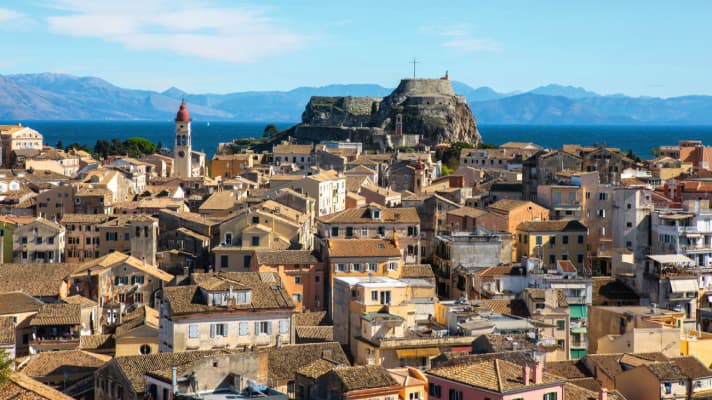
The city of Corfu is easily recognisable from afar; not only because of the old fortress on its high rock or the long rows of bright old town facades, but above all because of the four cruise ships and the many ferries. Two of them have just met, one leaving for the mainland, the other arriving. They are in a hurry, the competition is fierce. The swell is correspondingly heavy. Our destination is Mandraki harbour, right at the foot of the fortress. As there are two sailing clubs based here, you don't really have a chance of finding a berth in the high season. Even today it's getting tight, but thanks to a lot of good will we are able to get the stern into a gap at the quay wall. We get the murings through, put our wooden plank over from the starboard bathing platform and are ready to go ashore.
It is no coincidence that the old town has an Italian flair: Corfu belonged to the Republic of Venice for more than four centuries. The island was of enormous strategic importance to the trading power as a guardian at the gateway to the Adriatic. The importance of its fortifications with the carved Lion of St Mark is impressively demonstrated. The master builders utilised the existing rock bases to erect massive walls on them as if for eternity. They served their purpose: the Ottomans besieged Corfu three times and had to withdraw three times without success. The rule of the Venetians only ended in 1797, when the victorious Napoleon put an end to the history of the Republic and distributed its territories to other masters. Finally, in 1864, the Ionian Islands became part of the Kingdom of Greece.
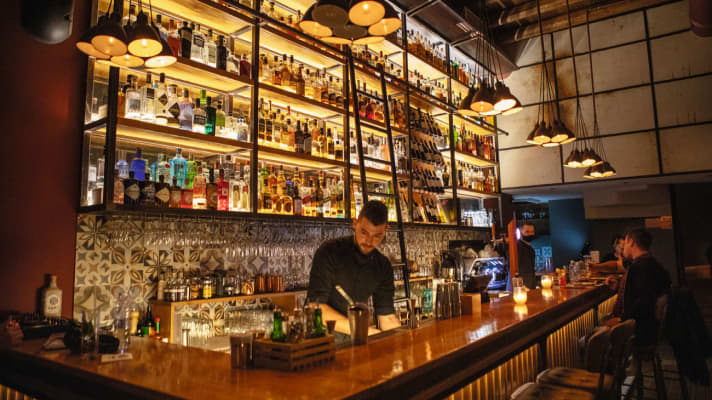
But it is only when it gets dark that Corfu shows its true colours: the whole town is on its feet; you can lose yourself in its narrow streets in the best sense of the word. Light shines and flickers everywhere and makes the stone glow, with candles and lanterns on the tables of the bars and cafés, fire bowls and torches in front of the restaurants. There are people everywhere, for example in Dimarchiou Square, where the town hall is located. Is it always like this? Or is it the last big celebration before winter? There are suspiciously many quilted jackets and coats. The streets are flanked by arcades and balconies, and the shop windows are lined with art and kitsch. Saints, philosophers and superheroes compete for the best seats, and those who want to arm themselves against the evil eye buy a pendant with a blue eye. After a meandering tour, our evening ends at a table in the Sway Bar on Enoseos Square, not far from the moat, with an unobstructed view of the passing life.
Under sail to Syvota
On our first longer sea leg the next day, we set our sights on Syvota, which lies twenty nautical miles south-east on the mainland. The storm continues to keep its distance and allows us a relaxed crossing over barely moving water. A light veil has covered the sky, dampening the sun somewhat. The few sailors we see are struggling with the faint breeze or motoring like us.
Syvota lies on the shore of a U-shaped bay, surrounded by wooded hills and shielded to the south by a group of three small islands. Even though we enter Kiellinie with two sailing catamarans on the last nautical mile, there is no shortage of space at all. In the harbour basin of the marina, the few yachts are even moored alongside, and almost everything is still free on the pier directly in the town. We turn our Powercat on the spot, drop the anchor and back up to the wall, which is just the right height.
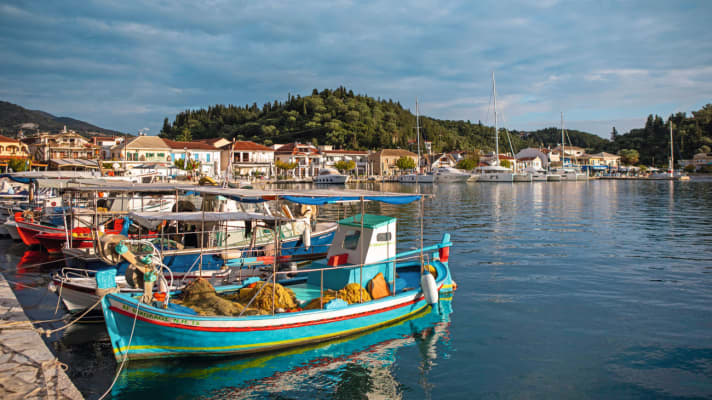
The last holidaymakers have already left and the hotel built on the hillside is closed for the winter. Most of the restaurants along the wide promenade have also emptied their terraces and tied up their parasols. The ticket stand for excursions to the island of Paxos is deserted, with one last flyer stuck in a notch. Nevertheless, the few boat tourists who are still travelling, like us, have not been forgotten. As agreed, a supermarket is still open, as is the family restaurant Georgeos, just a few steps from the water. There's feta from the oven, grilled swordfish and an ouzo to finish. The cats wait to see what comes off.Jámas - for your well-being! It gets dark early and the radiant heaters are on. Quite chilly - at least by Mediterranean standards.
Waves are to be expected
The next morning, we feel the breath of the monster for the first time: we want to cross over to Paxos, to the bay of Lakka at the northern tip of the island; a place that all cruising guides unanimously describe as a dream come true. The way there leads across the Strait of Paxos. It separates the island and its small neighbour Antipaxos from Corfu in the north and the mainland in the east. We had already been told at the charter base that you always have to expect waves here. But as we leave Syvota and the shelter of the offshore island of the same name, we are taken by surprise: the cyclone sends its swell from the south, the wind blows weakly but steadily from the north-west. Where we are, the two meet. The resulting short, steep wave is up to one metre high. Fortunately, it doesn't come completely from abeam, but from slightly ahead on the port side, so we can hold our course. It's just as well that we've made everything seaworthy below deck. With rolling movements like that, coffee machines and toasters quickly learn to fly!
The water suddenly looks much darker. You realise that the sea means business now. The spray is already foaming wildly around the jagged coastline astern. Far to the south, Levkas rises as a blue shadow above the horizon. To starboard, on the other hand, Cape Asprokavos, the southernmost point of Corfu, stands close and clear with its fantastic formations: a steep coastline as if made of surging, fossilised waves. Ahead lies Paxos, still ten nautical miles away. The wind picks up and soon the first whitecaps are visible. It's going to be a real ride.
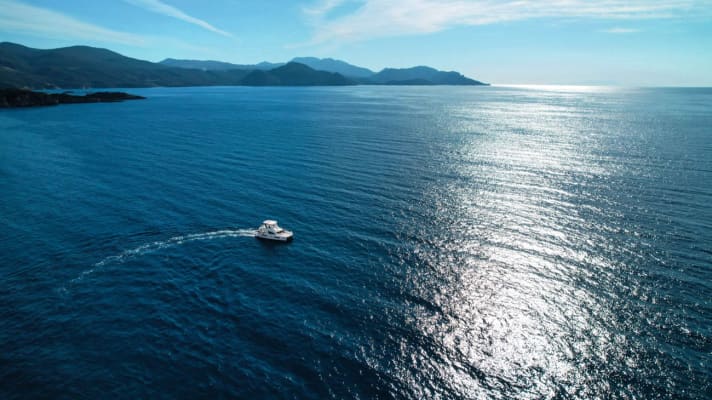
Then, after a good hour, we make it: we steer into the narrow entrance to the bay of Lakka - and right into paradise. The water glows turquoise above the sandy bottom. It is so clear and calm that our catamaran seems to float above its own shadow. In the high season, the yachts fight over the shoals here, but now it's free choice. We swim, paddle and soon our iron is resting on the bottom. We urgently need some exercise, so we put the dinghy in the water to go ashore. We quickly find a restaurant for later; the Taverna Nionios on the market square is still open. But first we walk between olive trees and dense bushes along a winding road up to the lighthouse. As befits a place like this, the view here is unobstructed into the blue distance.

